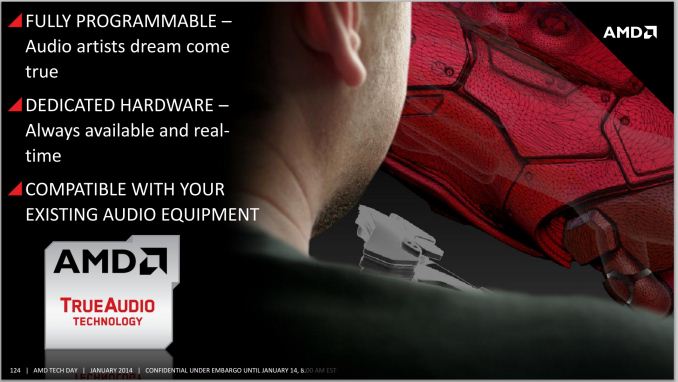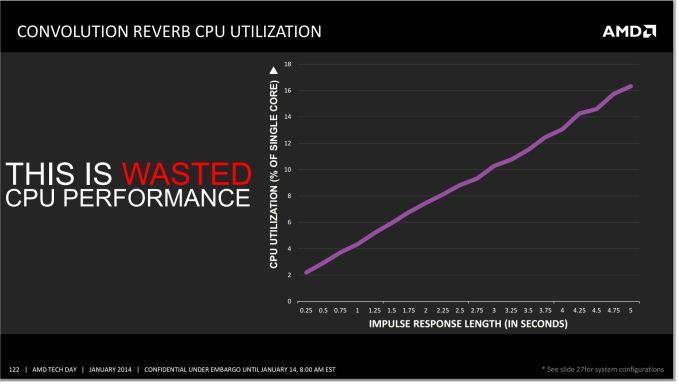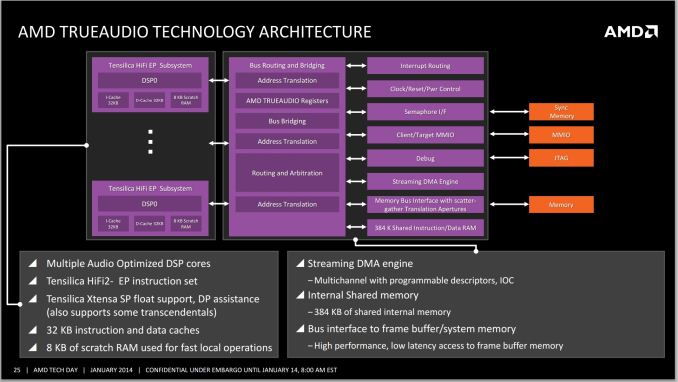AMD Kaveri Review: A8-7600 and A10-7850K Tested
by Ian Cutress & Rahul Garg on January 14, 2014 8:00 AM ESTTrueAudio
As part of the Kaveri package, AMD is also focusing on adding and updating their fixed function units / accelerators. Due to the jump on the GPU side to GCN we now have the TrueAudio DSP to allow developers to increase the audio capabilities in game, and both the Video Codec Engine (VCE) and Unified Video Decoder (UVD) have been updated.
All the major GPU manufacturers on the desktop side (AMD, NVIDIA, Intel) are pushing new technologies to help improve the experience of owning one of their products. There are clearly many ways to approach this – gaming, compute, content consumption, low power, high performance and so on. This is why we have seen feature like FreeSync, G-Sync, QuickSync, OpenCL adoption and the like become part of the fold in terms of these graphics solutions.
AMD’s new feature is TrueAudio - a fully programmable dedicated hardware element to offload audio tasks to.
The main problem with developing new tools comes down to whether they should be implemented in a general fashion or with a dedicated element. This comes down to the distinction of having a CPU or an ASIC do the work – if the type of work is specific and never changes, then an ASIC makes sense due to its small size, low power overhead and high throughput. A CPU wins out when the work is not clearly defined and it might change, so it opens up the realm of flexibility in exchange for performance per watt.
CPUs are now significantly powerful that a range of audio based techniques are available to them and the algorithms are optimized. The only limitation in this regard is the imagination of the developer or audio artist, which actually becomes part of the problem. When implementing an audio filter on the fly to a video game, the processing via the CPU can be overly taxing, especially when the effect is persistent over a long time. The example AMD gave in their press slide deck is one of adding reverb to an audio sample. The longer the reverb, the bigger the draw on CPU resources:
AMD cites this CPU usage as the effect of one filter on one audio sample. Imagine being in a firefight situation in a video game, whereby there are many people running around with multiple gunshots, splatter audio and explosions occurring. Implementing effects on all, and then transposing audio location to the position of the character is actually computationally expensive, all for the sake of realism. This is where the TrueAudio unit comes into play – the purpose is to offload all of this onto a dedicated bit of silicon that has the pathways built in for quicker calculations.
TrueAudio is also implemented on AMD's latest-generation R9 260 and R9 290 video cards – basically anything at least GCN 1.1 and up. Meanwhile we also know that the PS4’s audio DSP is based on TrueAudio, though given the insular nature of console development it's not clear whether the APIs are also the same on both platforms. AMD for their part is working with major audio middleware plugins (wwise, Bink) in order to help develop the TrueAudio ecosystem, so even in the case where the APIs are dissimilar, middleware developers can abstract that and focus on the similarities in the hardware underneath.
As is usually the case for these additional hardware features, games will need to specifically be coded to use TrueAudio, and as such the benefits of TrueAudio will be game specific. At the same time there are not any games currently on the market that can take advantage of the feature, so the hardware is arriving before there is software ready to use it. The first three games on AMD's list that will support TrueAudio are Murdered: Soul Suspect, Thief, and Lichdom. Much like FreeSync, I expect the proof is in the pudding and we will have to wait to see how it can affect the immersion factor of these titles.
Unified Video Decoder and Video Codec Engine
I wanted to include some talk about the UVD and VCE with Kaveri as both are updated – we get UVD 4, an update to error resiliency for H.264, and VCE 2, as shown below:
Of the two blocks, the improved VCE has the more interesting improvements to discuss. With the addition of support for B frames in H.264 encoding, the resulting ability to do backwards frame prediction should help improve the resulting image quality from VCE and/or reduce the required bitrates for any given quality level. Meanwhile the addition of support for the higher quality YUV444 color space in the H.264 encoder should help with the compression of primarily linear lineart/text, which in turn is important for the clarity of wireless displays.





















380 Comments
View All Comments
ImSpartacus - Thursday, January 16, 2014 - link
"Whether or not AMD decides to develop an APU with more than 8 GCN CUs is another matter. This is a point we've brought up with AMD internally and one that I'm curious about - do any AnandTech readers have an interest in an even higher end APU with substantially more graphics horsepower? Memory bandwidth obviously becomes an issue, but the real question is how valuable an Xbox One/PS4-like APU would be to the community."I would love to see a massive APU with a Pitcairn-sized GPU. I wouldn't mind if it required a 130-150+W TDP.
I love seeing machines like the 4770R-powered Brix Pro. Valve obviously likes it as well, because it became the Steam Box sent to developers.
If I'm getting the performance of a ~$200 GPU, I'd happily pay $300 to get the CPU baked in. I'm hoping DDR4 will allow Intel or AMD to pursue this kind of market.
Haravikk - Friday, January 17, 2014 - link
I'm really interested to find out what the dual graphics performance will be like now that AMD's APUs are much more up-to-date at long last.CrossFire using an APU and a discrete GPU has been entirely underwhelming thanks to how limited compatibility was, so much so that you are always better off fitting a better discrete GPU instead. The only case it remained interesting was for small form factors where the more limited range of low-profile cards (and less aggressive pricing) meant that compatible cards weren't always so far behind newer ones.
But with GCN graphics, HSA and Mantle on the way, maybe we might finally see the benefit of pairing the two rather than just using a better pure CPU and discrete graphics. Of course, we could see some benefit already if more games used OpenCL for physics, since that at least would run quite well on an APU even if the discrete GPU still did all the heavy graphical work.
Klimax - Friday, January 17, 2014 - link
Tests are very incomplete. Where are CPU+GPU results? AMD markets APU as total solution, so as such it should be tested. So far I have seen only Luxmark set of results on TechReport and when CPU+GPU was set, APU lost, because CPU part is sufficiently weak, that not even powerful GPU was able to save it.Also some OpenCL tests are not marked whether CPU+GPU or GPU-only, which can skew things badly.
eanazag - Friday, January 17, 2014 - link
I think this article is good, but it deserves and needs some dings on it because it is on Anandtech. When we look at the benchmark section there is a disconnect between this article (the applications used for benchmarking) and the Bench portion of the website. I have enjoyed and trusted the bench methodologies used on this site over the years and find it a resource I come back to, to help me make purchasing and hardware decisions because of the bench. Over time I will find it difficult to compare findings without the bench. I have no problem with you updating the bench as what has been done with SSDs and GPUs. I just think this article overlooked what becomes the real value of what this site offers if you overlook the ongoing bench portion of this site. I looked in the bench and haven't really seen a whole lot of anything recent on AMD APUs in the bench. That's my first ding.I suspect that if Anand was excited about AMD's release and had reviewed this product we would have gotten a better appreciation of what Kaveri brings to the table. I got the message that the 45W part is a very good in its segment and may be something worth considering, but I did not get what is mentioned in the article. What's the reality of running Kaveri on 1080p? You gave us the high settings, but no one with any sense is going to settle for less than 12 fps. So what are the realistic settings that will give us 20/30+ fps (game depending) performance. What are we really able to work with. I understand Anand is busy and likely not excited about another AMD CPU product release. I get it; it is hard to get excited about desktop and higher wattage laptop parts for AMD because they have been lack luster & underwhelming year over year for so long. I think this product fits in more than just the 45W space, but I didn't get that answer. I am still wondering, which is not what I would normally get at Anandtech. Normally, I would be getting more than I expected from a review. That's my second ding.
This next is a general ding about the bench. You guys do great work here. I am on here about every day. The bench could use some tweaking in relation to the CPU and GPU between laptop and desktop and to an extent mobile. I want to know how a mobile GPU/CPU matches up to a desktop variant. Sometimes I even want to know how they match up in mobile devices (tablets and phones). I have gotten some of that info from articles, but it is rough matching up that info in the mobile (laptop) bench. Sometimes I do want to look at specific laptop info, but most of the time I am just considering the guts of the device. I decide between the trade offs of desktops to laptops in applications. The information is here, but it is not easy to compare. This is an opportunity for improvement, especially given the nature of the changing technology landscape.
This is an addendum to the bench issue. I'd like to compare server processors too. It seems to me like in some niches we might start seeing server parts fill over the places where those highend desktop parts were. I already see this in AMD. Intel is on the cusp of this also. This is something to consider. I'd also like to see some more enterprise items covered in general. AMD is selling ARM servers already? Where have I been? And there are ARM based linuxes available.
Thanks for the great work and timely info.
HisDivineOrder - Saturday, January 18, 2014 - link
"The point I am making with this heart-warming/wrenching family story is that the Kaveri APU is probably the ideal fit for what he needs. Strap him up with an A8-7600 and away he goes. It will be faster than anything he has used before, it will play his games as well as that new HD 6750, and when my grandmother wants to surf the web or edit some older images, she will not have to wait around for them to happen. It should all come in with a budget they would like as well."OR you could buy him a cheapo dual-core CPU from Intel plus a used mid-range card from a year or two ago.
Far better performance for only a bit more. There is an argument forthese APU's in gaming and it's for those who want to game with something like a Gigabyte BRIX-sized computer that trades performance for size.
Performance per dollar does not favor the APU simply because you can get so much more performance ignoring these APU's altogether.
NinuGie - Saturday, January 18, 2014 - link
such wow much fail. until APU comes in desktop format there will always be better alternatives. i want to see an APU compact format and similar to what they did on PS4. shared fast RAM .until then,they suck. i mean this is so bad implemented. and they advertise it for gamers lol. even if you CF the apu with a supprted gpu ,a HD 7770 is better so no thank youarthur42 - Sunday, January 19, 2014 - link
The A10-6700T is in good supply in Europe; I'm running one for months now.aidnr - Monday, January 20, 2014 - link
I'm pretty impressed with what they've done here, it looks like it is pretty evenly matched with Intel's offering - http://versus.com/en/amd-a10-7850k-vs-intel-core-i...Will be interesting to see how widely adopted Mantle is, seems pretty nice.
samal90 - Monday, January 20, 2014 - link
Can someone explain to me how come AMD is able to make an incredible APU capable of running games at almost 60fps on the new consoles but can't make a desktop APU to do so? Why can't they use the same architecture? Maybe I'm missing something...but I'm just wondering.meacupla - Wednesday, January 22, 2014 - link
Because PS4/XB1 is not limited to using FM2+ socket, because they use a much slower CPU portion in PS4/XB1 and because of thermal limits.